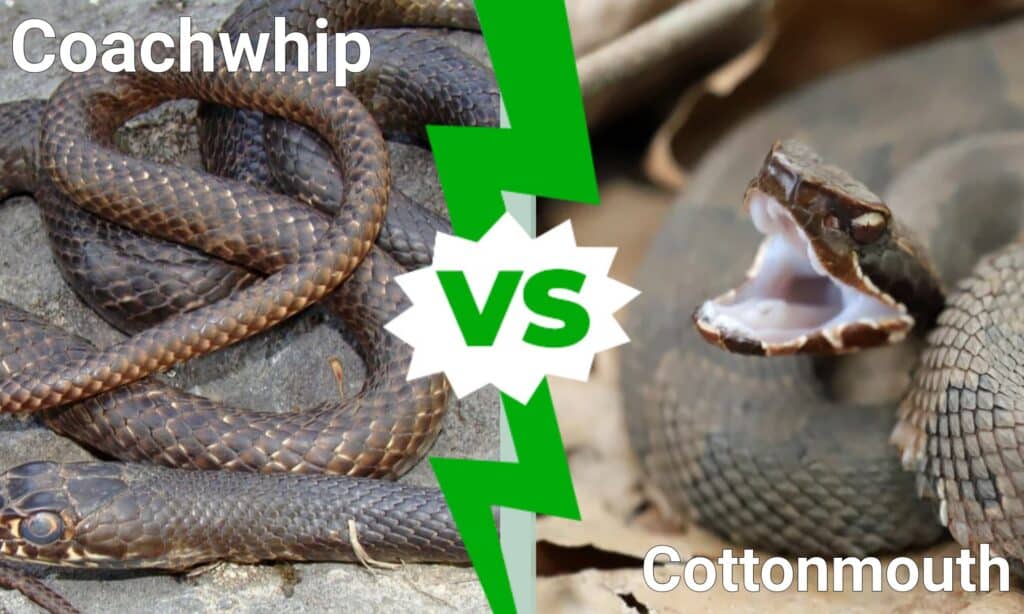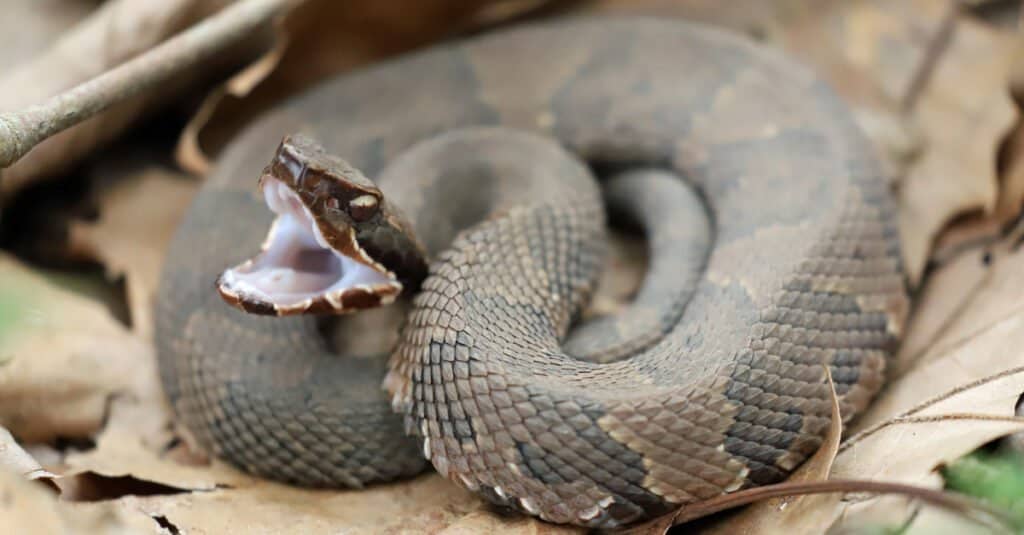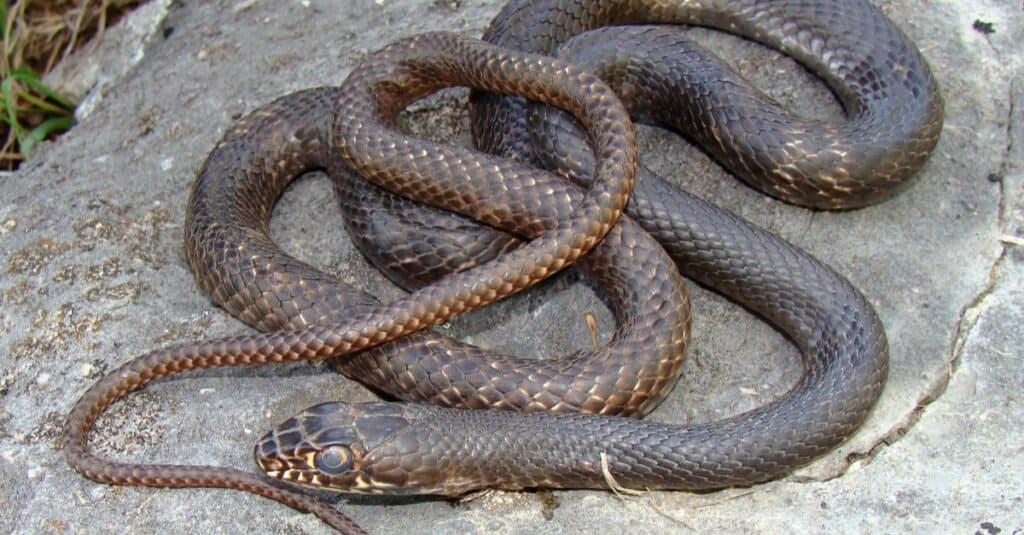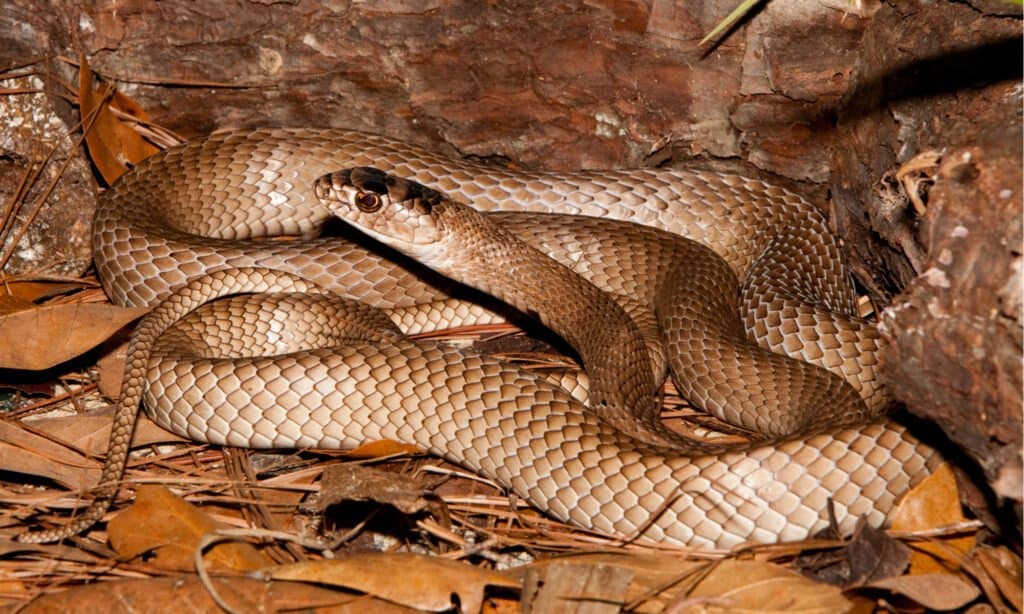Coachwhip snakes and cottonmouths have overlapping ranges, so understanding their differences is vital to proper identification. While they try to flee from humans, both will stand their ground if they are overly threatened. Cottonmouths are commonly called water moccasins.
Coachwhips can be found across the southern United States from California to the Atlantic, as well as in Northern Mexico. Cottonmouth snakes are found in the same general region.
What are the differences when it comes to coachwhip snakes vs cottonmouths? Let’s look at some key differences and other interesting facts about these two snakes so you’re better equipped to tell them apart.
Key Differences Between a Coachwhip Snake vs Cottonmouth

The key differences between a coachwhip and a cottonmouth is whether they’re venomous, their appearance, their preferred habitat, how they stalk and eat prey, and how they reproduce. The cottonmouth is a venomous pit viper while the coachwhip snake is a nonvenomous whip snake.
Coachwhip snakes have a tapering color to them with a crosshatched scale pattern while cottonmouths are crossbanded. Cottonmouths prefer semi-aquatic environments whereas coachwhips prefer dry land, although both can swim.
Coachwhips may eat their prey alive, while cottonmouths kill prey with venom. Coachwhips lay eggs, whereas cottonmouths give birth to live young. Let’s look at each of these differences in more detail below!
Coachwhip Snake vs Cottonmouth: Their Bite

Cottonmouths got their name because their mouths were as white as cotton.
©KF2017/Shutterstock.com
Coachwhip snakes are nonvenomous, so despite their painful bite, they pose little threat to humans. These snakes are not trying to bite humans, but they will lash out in self-defense after raising their heads as a warning.
Cottonmouth snakes are venomous, and their bite will destroy tissue. There is an antivenom available, so seek treatment immediately if you’ve been bitten by a cottonmouth. While cottonmouths deliver a much smaller amount of venom in self-defense than they do against prey, a bite still needs immediate medical attention.
It’s interesting to note that there is a medical use for the venom of a cottonmouth. It’s used to treat blood clots since the venom helps with anticoagulation, though more trials need to be conducted around the cottonmouth venom’s viability as a medical treatment.
Coachwhip Snake vs Cottonmouth: Appearance

Coachwhip snakes get darker from tail to head.
©Matt Jeppson/Shutterstock.com
Coachwhip snakes have a white or light tan tail that progressively gets darker toward the head. Their head is the darkest part of their body and is usually a shade of brown, though their main coloration can vary by region.
Coachwhips have small heads with big eyes and are extremely thin snakes for their size. They have a crosshatch pattern that looks like an old whip which is how they earned the name coachwhip.
Cottonmouths have a startlingly white mouth when they open it. They received their name for their mouth coloring since their mouths are as white as cotton. That’s why a few of the nicknames for cottonmouths include gapper and trap-jaw. Cottonmouths show their white mouths when threatened.
Coachwhip snakes have round pupils like most nonvenomous snakes, whereas cottonmouths have cat-eye pupils like most pit vipers. A cottonmouth’s body has crossbands over a consistent body color from head to tail.
Coachwhip Snake vs Cottonmouth: Hunting

Coachwhips can reach up to 8 feet but are much more slender than cottonmouths.
©Jay Ondreicka/Shutterstock.com
One way that cottonmouths identify their prey is by smelling with their tongues. They flick their tongues out, catch scent molecules, then press their tongues against an organ on the roof of their mouths. Cottonmouths are also pit vipers that have heat-sensing organs between their nostril and eyes — these allow the snakes to see in the dark. They bite their prey, inject venom, and then sit back and wait for it to die.
Coachwhips rely on their sight when hunting. They go after their prey with their heads held high so they can better see what’s around them. Both coachwhip snakes and cottonmouths can swim, but cottonmouths are expert hunters on both land and in the water whereas coachwhip snakes avoid water if they can.
Most snakes wait to ambush their prey, but coachwhips pursue it. Once they catch it, they pin it down with their body and begin chewing on it. If they can, they’ll swallow it whole while it’s still alive. Cottonmouths are also known to pursue their prey, but they tend to lie in wait for the perfect ambush.
Coachwhip Snake vs Cottonmouth: Habitat

Water moccasins (cottonmouths) are comfortable in the water.
©Seth LaGrange/Shutterstock.com
Coachwhip snakes like soil that’s sandy and loose. They live in sandhills, fields, prairies, dunes, and open forests. They’re out during the hottest part of the day and seek shelter in underground burrows they’ve created. Sometimes they hide out under things if they aren’t in their burrow.
Cottonmouths prefer wet areas like floodplains, bays, lakes, and swamps. That’s because they’re semi-aquatic and need both water and land to flourish.
Habitat loss is a concern for the coachwhip, although they aren’t endangered anywhere except Illinois. Cottonmouths are also somewhat threatened by humans, though they still exist in healthy numbers.
Coachwhip Snake vs Cottonmouth: Diet
Coachwhip snakes like to dine on rodents, lizards, amphibians, birds, and insects. Cottonmouths chow down on birds, eggs, smaller snakes, frogs, insects, and turtles. The babies of both snakes dine on insects until they grow older.
Coachwhip Snake vs Cottonmouth: Speed
In the Americas, the coachwhip snake is one of the fastest-moving snakes at around 4 mph. Cottonmouth snakes can move a little faster than that on both land and in the water, and they also have the fastest strike time out of any other venomous snakes. They can strike their prey at about 10 mph.
Coachwhip Snake vs Cottonmouth: Reproduction
Coachwhips breed in the spring and summer, and a female will mate with more than one male per season. She then lays an average of 11 eggs in her burrow and it takes a bit over 2 months for the babies to hatch.
A cottonmouth doesn’t lay eggs but instead, the mother carries them internally, each separated by a thin membrane, until they’re ready to hit the ground slithering. Both cottonmouths and coachwhips do not rear their young and their babies are ready to fend for themselves as soon as they’re born or hatched.
Cottonmouths breed in late spring, and males court females through a dancing ritual. Males will battle with one another over a female, and cottonmouths only mate with one partner. If a female is unable to mate, she can use asexual reproduction.
Coachwhip Snake vs Cottonmouth: Hibernation (Brumation)
Coachwhip snakes hibernate in the winter for energy conservation. Cottonmouths also hibernate in the northern parts of their region. Both cottonmouths and coachwhips occupy dens made by other animals or find a good hiding spot amongst rocks or logs during hibernation.
A snake’s hibernation is called a brumation because the processes that a reptile undergoes as a cold-blooded animal are different from the process of hibernation exhibited by warm-blooded creatures.
The photo featured at the top of this post is © Alexander Wong/Shutterstock.com
Discover the "Monster" Snake 5X Bigger than an Anaconda
Every day A-Z Animals sends out some of the most incredible facts in the world from our free newsletter. Want to discover the 10 most beautiful snakes in the world, a "snake island" where you're never more than 3 feet from danger, or a "monster" snake 5X larger than an anaconda? Then sign up right now and you'll start receiving our daily newsletter absolutely free.
Thank you for reading! Have some feedback for us? Contact the AZ Animals editorial team.






